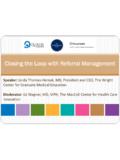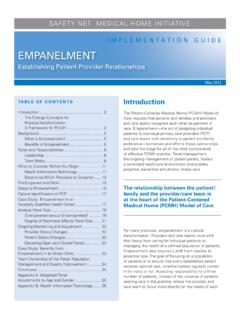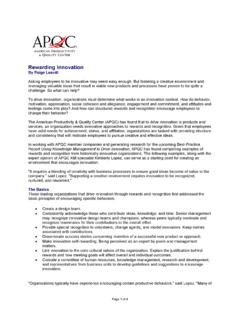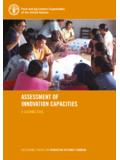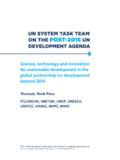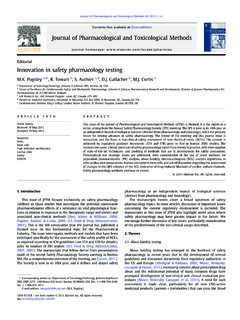Transcription of PATIENT-CENTERED MEDICAL HOME ASSESSMENT (PCMH-A)
1 SAFETY NET MEDICAL home INITIATIVEPATIENT- centered MEDICAL home ASSESSMENT (PCMH-A) Organization name Site name Date completedPage 2 of 16 Version (September 2014) 2014 MacColl Center for Health Care Innovation, Group Health CooperativeIntroduction To The PCMH-A The PCMH-A is intended to help sites understand their current level of MEDICAL homeness and identify opportunities for improvement. The PCMH-A can also help sites track progress toward practice transformation when it is completed at regular PCMH-A was developed by the MacColl Center for Health Care Innovation at the Group Health Research Institute and Qualis Health for the Safety Net MEDICAL home Initiative (SNMHI).
2 The PCMH-A was extensively tested by the 65 sites that participated in the SNMHI, including federally qualified health centers (FQHCs), residency practices, and other settings, and is in use in a number of regional and national initiatives. Before you Begin Identify a multidisciplinary group of practice staff We strongly recommend that the PCMH-A be completed by a multidisciplinary group ( , physicians, nurses, MEDICAL assistants, residents, other operations and administrative staff) in order to capture the perspectives of individuals with different roles within the practice and to get the best sense possible of the way things really work.
3 We recommend that staff members complete the ASSESSMENT individually, and that you then meet together to discuss the results, produce a consensus version, and develop an action plan for priority improvement areas. We discourage sites from completing the PCMH-A individually and then averaging the scores to get a consensus score without having first discussed as a group. The discussion is a great opportunity to identify opportunities and priorities for PCMH transformation. Have each site in an organization complete an assessmentIf an organization has multiple practice sites, each site should complete a separate PCMH-A.
4 Practice transformation, even when directed and supported by organizational leaders, happens differently at the site level. Organizational leaders can compare PCMH-A scores and use this information to share knowledge and cross-pollinate improvement where your practice is on the PCMH journeyAnswer each question as honestly and accurately as possible. There is no advantage to overestimating or upcoding item scores, and doing so may make it harder for real progress to be apparent when the PCMH-A is repeated in the future. It is fairly typical for teams to begin the PCMH journey with average scores below 5 for some (or all) areas of the PCMH-A.
5 It is also common for teams to initially believe they are providing more PATIENT-CENTERED care than they actually are. Over time, as your understanding of PATIENT-CENTERED care increases and you continue to implement effective practice changes, you should see your PCMH-A scores 3 of 16 Version (September 2014) 2014 MacColl Center for Health Care Innovation, Group Health CooperativeDirections for Completing the ASSESSMENT 1. Before you begin, please review the Change Concepts for Practice Transformation. 2. For each row, click the point value that best describes the level of care that currently exists in the site.
6 The rows in this form present key aspects of PATIENT-CENTERED care. Each aspect is divided into levels (A through D) showing various stages in development toward a PATIENT-CENTERED MEDICAL home . The levels are represented by points that range from 1 to 12. The higher point values within a level indicate that the actions described in that box are more fully implemented. 3. Review your subscale and overall score on page 15. These subscale and overall scores are automatically calculated based on the responses entered. Average scores by Change Concept (subscale scores) and an overall average score are provided.
7 Using the scores to guide you, discuss opportunities for improvement. 4. Save your results by clicking the save button at the end of the form. To clear your results, and retake the ASSESSMENT , click on clear button at the end of the form. Check your computer to make sure you have Adobe Reader or Adobe Acrobat. To complete this interactive PDF you will need Adobe Reader or Adobe Acrobat installed on your computer. Adobe Reader is free software, available here. SAVE CLEARPage 4 of 16 Version (September 2014) 2014 MacColl Center for Health Care Innovation, Group Health CooperativePART 1: ENGAGED LEADERSHIP 1a.
8 Provide visible and sustained leadership to lead overall culture change as well as specific strategies to improve quality and spread and sustain change. 1b. Ensure that the PCMH transformation effort has the time and resources needed to be successful. 1c. Ensure that providers and other care team members have protected time to conduct activities beyond direct patient care that are consistent with the MEDICAL home model. 1d. Build the practice s values on creating a MEDICAL home for patients into staff hiring and training DLevel CLevel BLevel A1.
9 Executive focused on short-term business support and create an infrastructure for quality improvement, but do not commit resources and actively reward quality improvement continuous learning throughout the organization, review and act upon quality data, and have a long-term strategy and funding commitment to explore, implement and spread quality improvement initiatives. 1 2 3 4 5 6 7 8 9 10 11 122. Clinical focus on improving developed a vision for quality improvement, but no consistent process for getting committed to a quality improvement process, and sometimes engage teams in implementation and problem consistently champion and engage clinical teams in improving patient experience of care and clinical outcomes.
10 1 2 3 4 5 6 7 8 9 10 11 123. The organization s hiring and training only on the narrowly defined functions and requirements of each how potential hires will affect the culture and participate in quality improvement a priority on the ability of new and existing staff to improve care and create a PATIENT-CENTERED and sustain improvements in care through training and incentives focused on rewarding PATIENT-CENTERED care.
